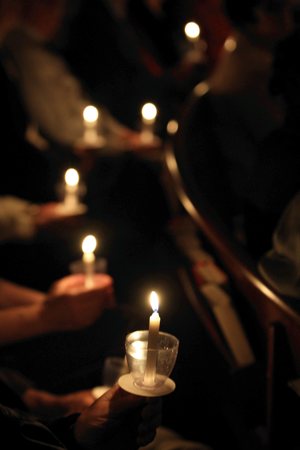
A primer on the longest liturgy of the year
Easter is the greatest feast in the life of the Church. On this day the faithful celebrate Jesus’ resurrection from the dead and our hope in our own salvation. While every Mass on Easter is special in its own way, the Easter Vigil is the pinnacle of the Church’s liturgical life.
The website for the U.S. Conference of Catholic Bishops provides directions for the celebration of the Easter Vigil taken from the Roman Missal. The rubrics (instructions) for celebrating the vigil call it the “greatest and most noble of all solemnities, and it is to be unique in every single church.”
This means that each parish is to celebrate only one Easter Vigil to which all of its members are invited, regardless of language or cultural group.
The word “vigil” means to stay awake and watchful. During the Easter Vigil the Church stands watch, waiting for the resurrection of the Lord. As the Roman Missal puts it, this is “the turning point of the triduum, the Passover of the new covenant, which marks Christ’s passage from death to life.”
The rubrics call for the vigil to take place after nightfall on Holy Saturday and end just before dawn on Easter Sunday.
In some parishes the vigil lasts throughout the entire night, but in most the vigil will last two or three hours. There is more than enough richness in this liturgy to fill whatever time is dedicated to it.
• The vigil begins with the lighting of the Easter fire. The rubrics call for a “blazing fire” so that people can experience its warmth and light overcoming the cold and darkness of night. Smaller fires are permissible as circumstances dictate, but a larger fire is clearly desired.
After the fire is started and blessed, the paschal candle is prepared. On lighting the candle from the fire the priest prays for all to hear, “May the light of Christ, rising in glory, dispel the darkness of our hearts and minds.”
The priest then carries the lit candle into the totally dark worship space, leading the faithful, who now all hold unlit candles. Three times during the procession the words “Light of Christ” are sung loudly.
• The Easter proclamation (the Exsultet) is then sung. The words of this proclamation call on all of creation to give joyful praise to God for the salvation offered to us all through the resurrection of the Lord.
This ancient hymn recounts briefly the story of salvation history: the sin of Adam, the feast of Passover, crossing the Red Sea, the coming of the Messiah. On this night wickedness is dispelled, faults are washed away, innocence is restored and people who mourn are filled with joy.
As the worship space is filled with light from all of the candles, the prayer is sung asking that this light “may persevere undimmed, to overcome the darkness of this night.”
• The vigil now proceeds with the Liturgy of the Word. Unlike the usual Sunday liturgy, seven passages from the Old Testament are provided to flesh out the salvation history presented in the Exsultet.
Following each of the readings is a responsorial psalm, time for meditation and a prayer led by the priest celebrant. This is followed by a reading from the New Testament and the proclamation of the Resurrection narrative from the Gospels.
The Roman Missal notes that all nine of the readings “must be read whenever it can be done, so that the character of a vigil that takes place over some duration of time can be observed,” although the number of Old Testament readings may be reduced to three for “grave pastoral circumstances.” The vigil concludes with the rite of baptism for those entering the Church and then the celebration of the Eucharist.



